Camp Rhododendron (Civilian Conservation Corps camp, 1936-1942)
Introduction
Text-to-speech Audio
Images
Three Camp Rhododendron members with the camp sign
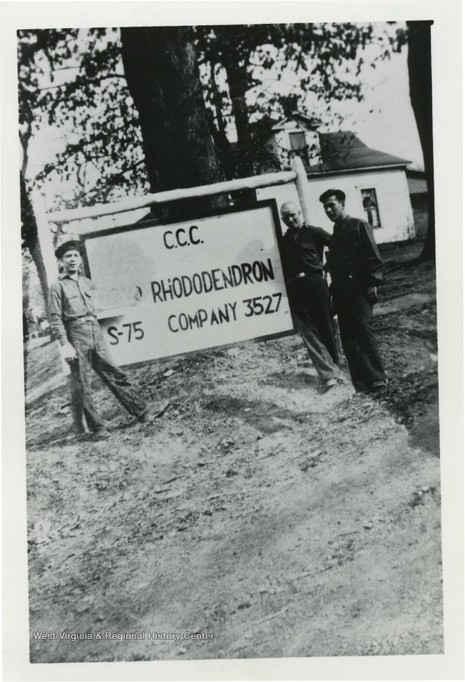
View of the temporary CCC camp buildings
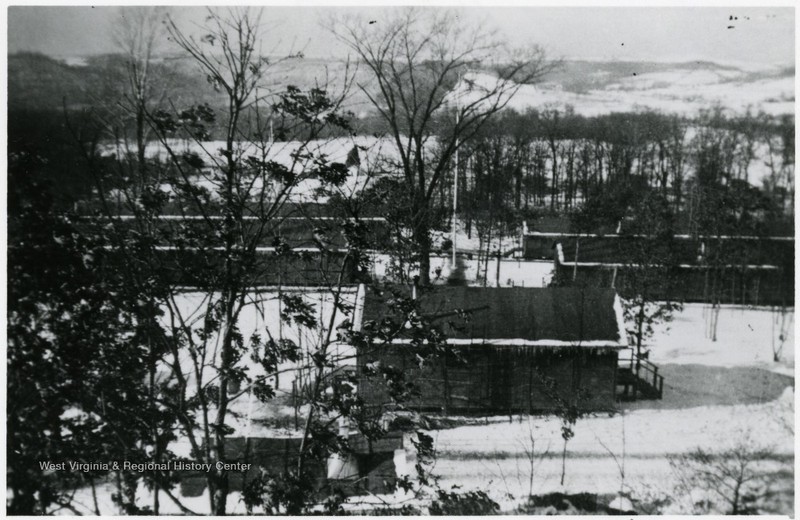
A Camp Rhododendron member with a CCC sign
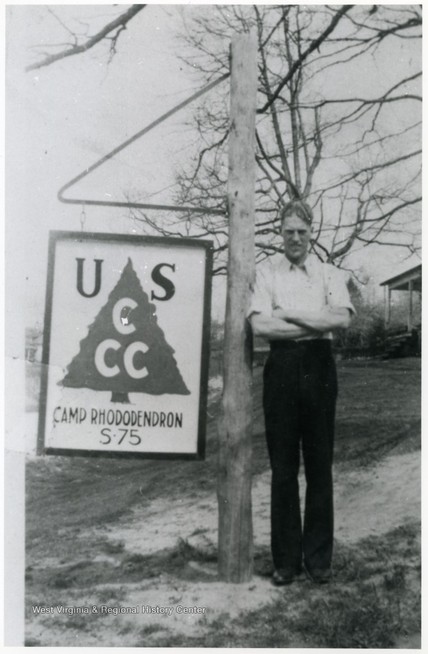
View of the road leading into Camp Rhododendron. The camp sign is barely visible in the bottom left
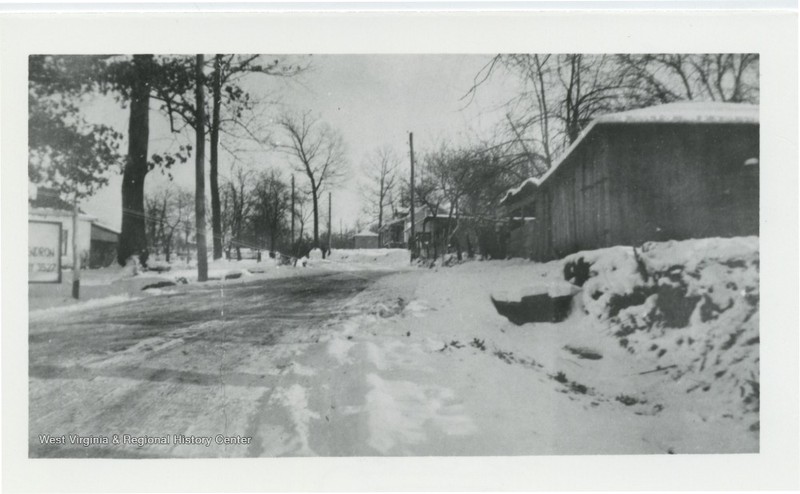
First-prize winning model of Coopers Rock constructed by Camp Rhododendron members for the 1936 Mountain State Forest Festival in Elkins, WV
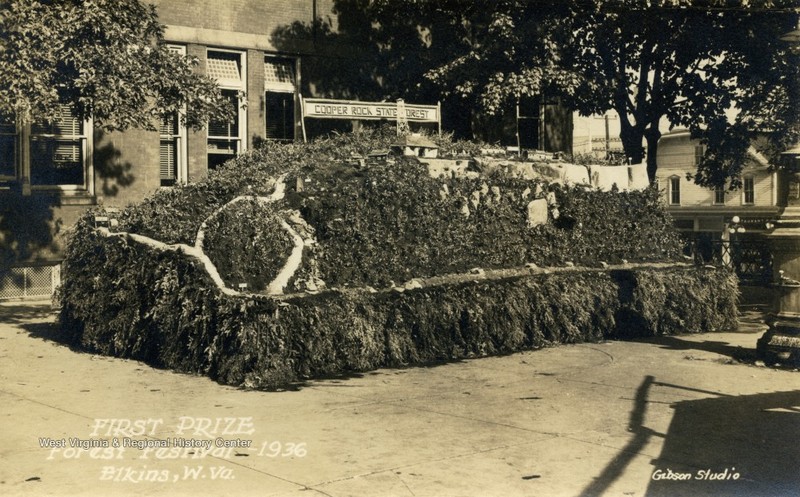
Backstory and Context
Text-to-speech Audio
The Civilian Conservation Corps (CCC) was born from the brutal economic downturn experienced across America in 1933 that left one in four men unemployed. Franklin Roosevelt – already quite interested in conservation and preservation of natural resources – saw the need for both employment opportunities and stewardship of the land. In a proposal to Congress on March 21, 1933 he advocated for the CCC, “to be used in complex work, not interfering with normal employment and confining itself to forestry, the prevention of soil erosion, flood control, and similar projects. I call your attention to the fact that this type of work is of definite, practical value, not only through the prevention of great financial loss but also as a means of creating future national wealth.” By July of the same year there were over 1400 functioning camps and over 300,000 enrollees. These enrollees were primarily male, unmarried, unemployed, and between eighteen and twenty-five.
The Camp Rhododendron CCC organization was an evolution of an earlier camp in Preston County named Camp Fairfax. Camp Fairfax had the opportunity to complete none of its prescribed road and telegraph line construction before being moved to the Cheat Lake area, near Sunset Beach, in 1936. The reason for relocation was the acquisition of the land around Coopers Rock by West Virginia with the intention of establishing a state park. In addition to securing the land, the state also managed to procure funding for a CCC company to complete work on the new park. Approximately 135 men made this move to become Camp Rhododendron.
Improvements to the Coopers Rock area commenced by May of 1936. The first order of business involved constructing makeshift bridges to the rock formations that compose the overlook. Camp Rhododendron then created a path from Route 73 (now Interstate 68) to the newly accessible overlook. Over the next five years, Camp Rhododendron created a variety of administrative and recreational facilities for Coopers Rock State Forest. These include picnic pavilions, a remote shelter, and a first-aid building. They also completed a variety of landscaping tasks such as trailblazing forest paths, delineating the park perimeter with wire, and creating stone retaining walls and runoffs. Construction on one of the most important Camp Rhododendron buildings, the superintendent’s house and garage, began in 1938 and was completed in 1940. The site chosen for these two buildings is on the opposite side of Route 73 from the other Camp Rhododendron structures.
Camp Rhododendron was not limited only to labor activities. Members were one of twenty CCC camps selected to participate in an experimental educational program; the National Forum. Each week, a scholar visited the camp and spoke before opening the floor to questions and debate. Camp members were also involved in state-wide recreational pursuits, such as baseball. Additionally, in 1936, the camp took first-prize at the Mountain State Forest Festival in Elkins, WV for their model of Coopers Rock State Forest and the planned improvements.
Though June 30, 1942, marks the end of CCC operations, the impact of the program and Camp Rhododendron is difficult to overstate. A 2015 economic significance study estimates that the Coopers Rock park directly and indirectly generates almost 7.1 million dollars for the state each year. This makes it the second most valuable state park in West Virginia – it generates only 300,000 fewer dollars than first-place Kanawha Forest. Camp Rhododendron was critical to placing northern West Virginia on a national map as a tourist destination. The camp itself was disassembled in 1942, but the Camp Rhododendron legacy remains visible in the impact on the landscape and the buildings that sit upon it.
Sources
Redmond, Pamela Ball. Camp Rhododendron Recreational Historic Area, National Register of Historic Places. December 15th 1990. Accessed August 7th 2020. http://www.wvculture.org/shpo/nr/pdf/monongalia/91000545.pdf.
Redmond, Pamela Ball. Coopers Rock State Forest Historic Resources, National Register of Historic Places. December 14th 1990. Accessed July 15th 2020. https://npgallery.nps.gov/GetAsset/7b0d8406-fce1-47f8-af4a-ab41cb9a4921.
Redmond, Pamela Ball. Coopers Rock State Forest Superintendent's House and Garage, National Register of Historic Places. December 15th 1990. Accessed July 15th 2020. http://www.wvculture.org/shpo/nr/pdf/monongalia/91000546.pdf.
Roosevelt, Franklin D. Message to Congress on Unemployment Relief, The American Presidency Project. Accessed July 15th 2020. https://www.presidency.ucsb.edu/documents/message-congress-unemployment-relief-0.
West Virginia & Regional History Center
West Virginia & Regional History Center
West Virginia & Regional History Center
West Virginia & Regional History Center
West Virginia & Regional History Center
